扩展功能
文章信息
- 贾连奇, 蔡春芳, 李红霞, 汪天凯, 张文, 孔令武
- JIA LianQi, CAI ChunFang, LI HongXia, WANG TianKai, ZHANG Wen, KONG LingWu
- 塔中地区热化学硫酸盐还原作用对深埋白云岩储层的改造
- Thermochemical Sulfate Reduction-related Mesogenetic Dissolution of Deeply Buried Dolostone Reservoirs in the Tazhong Area
- 沉积学报, 2016, 34(6): 1057-1067
- ACTA SEDIMENTOLOGICA SINCA, 2016, 34(6): 1057-1067
- 10.14027/j.cnki.cjxb.2016.06.005
-
文章历史
- 收稿日期:2016-05-20
- 收修改稿日期: 2016-08-17
2. 长江大学 武汉 430100 ;
3. 中国石油塔里木油田分公司勘探开发研究院 新疆库尔勒 841000 ;
4. 中海油研究总院 北京 100028
2. Department of Geochemistry, Yangtze University, Wuhan 430100, China;
3. Research Institute of Petroleum Exploration and Development, Tarim Oilfield Company, PetroChina, Korla, Xinjaing 841000, China;
4. CNOOC Research Institute, Beijing 100028, China
深埋碳酸盐岩储层(>4 500 m)是我国陆上油气勘探发展的重要接替领域,意义重大[1]。目前,在塔里木盆地埋深4 500~7 000 m的碳酸盐岩中发现了大量的油气,显示出巨大的资源潜力[1-2]。塔里木盆地最近的勘探资料显示,深逾6 000 m的井段还存在物性较好的储层。例如,塔深1井在8 402 m深的地层中仍发现直径8 cm左右的洞穴[3-4],中深5井在深达6 200 m的中寒武统阿瓦塔格组粉晶白云岩地层中见到油气显示,中深1井在下寒武统肖尔布拉克组6 597.6 ~ 6 785 m井段的储层中仍然发现较好的储层,日产气30 322 m3。类似地,国外碳酸盐岩油气勘探过程中发现了众多埋深大、物性好的储层实例[5-7]。然而,这些深埋碳酸盐岩储层中高孔隙的来源仍然有着较大的争议。
一般来说,海相碳酸盐岩的储层物性主要受控于原始的沉积特征(如沉积相、沉积组构、原始矿物、古气候、海平面波动等)和后期的成岩改造(如表生期和埋藏期流体改造)[8-10]。多数情况下,深埋碳酸盐岩储层经历后期压实、胶结、充填等成岩作用后,原生孔隙大量消失[5, 11-12]。Halley和Schmoker[11]研究了南佛罗里达地区灰岩孔隙度随埋深的变化,发现由于机械压实和胶结作用,灰岩埋深>5 000 m,孔隙度<3%,埋深>6 000 m,孔隙基本上消失殆尽。塔里木盆地经历多期改造,多期流体活动和复杂的成岩作用,形成于同生期和表生暴露期的孔隙可能只有少部分保存下来。如果保存下来的孔隙十分有限,那么在某些岩芯上观察到的丰富孔隙又是如何形成的?是否存在深埋藏环境下的强烈的溶蚀作用?
导致埋藏溶蚀的流体包括:有机酸、H2S、CO2、热液流体以及热化学硫酸盐还原作用(TSR)形成的流体[3]。热液流体是指比地层温度高(>5℃)的外部流体[13],由于化学性质与储层流体不同,破坏了原有的水—岩平衡,于是既可能导致矿物溶解,也可能导致沉淀作用。在碳酸盐岩储层内的埋藏溶蚀流体中,热液流体被认为是深埋优质储层分布的关键[14-15],北美、西班牙及中东的某些优质白云岩储层被认为是深层热液流体改造的结果[15-19]。塔中地区存在热液流体活动已经成为了共识[20-22],并认为热液流体活动对深埋碳酸盐储层具有明显的改造作用[23-28]。然而,TSR对深埋碳酸盐岩储层的改造研究较少,只有Li et al.[29]讨论了TSR对于奥陶系灰岩储层的影响。前人对于深埋碳酸盐岩储层的研究发现,在高H2S含量的深埋白云岩井段经常发现具有异常高的孔隙[3, 30-33]。塔中地区也发现含有较高H2S含量的白云岩储层,有必要探讨TSR对孔隙的影响。为此本文从流体地球化学角度入手,通过59口井岩芯样品的岩芯观察、薄片观察、阴极发光、扫描电镜、电子探针,包裹体均一温度、盐度,碳氧同位素等方法确定TSR发生及其对储层的改造作用。本项研究对于指导碳酸盐岩油气勘探具有理论和实际意义。
1 区域地质概况塔中隆起位于塔里木盆地中部,西与巴楚隆起相接,东邻东南隆起,南为西南坳陷,北接北部坳陷(图 1)。塔中隆起是一个在寒武纪—奥陶纪巨型褶皱背斜基础上形成并长期发育的继承性隆起,始于中晚奥陶世前,石炭纪前基本定型,海西期以后构造以小型改造为主[34]。塔中地区具有“东西分块,南北分带”的构造格局。将塔中隆起分为4个构造单元:Ⅰ-北斜坡;Ⅱ-中央断垒带;Ⅲ-南斜坡;Ⅳ-东部潜山区(图 1)。由于加里东中期强烈隆升,塔中地区经历了较长时间的剥蚀和沉积缺失,多数地区缺少一间房组、土木休克组沉积,鹰山组顶部发育准层状不整合面。奥陶系(O)为一套潮上至潮间带的局限台地至台地边缘相沉积,根据岩性、电性特征及区域对比,自上而下分为:上统桑塔木组、良里塔格组、中下统鹰山组、蓬莱坝组。上奥陶统为一套潮间带局限台地至台地边缘相沉积。桑塔木组(O3s)为暗色泥岩、泥灰岩。良里塔格组(O3l)为中厚层状灰色、浅灰色砂屑灰岩、含泥灰岩、泥灰岩、生屑灰岩。鹰山组(O1-2y):中、上部为中厚—巨厚层状灰岩,夹中厚—厚层状含泥灰岩,局部见一层泥质灰岩;下部为中厚—巨厚层状含云灰岩,间夹中厚层状含泥灰岩。属藻坪—潮间带下部或潮下边缘滩的沉积。蓬莱坝组(O1p):上部以中厚—巨厚层状含云灰岩、云质灰岩为主,夹中厚层状含泥灰岩、灰云岩;中部以中厚—巨厚层状云质灰岩、灰质云岩、中厚—厚层状灰云岩互层为主,夹中厚层状含泥云岩、含泥云质灰岩、泥质云岩;下部为厚—巨厚层状灰云岩、灰质云岩,夹一层厚的白云岩。属于一套潮间带—局限台地相沉积。寒武系(∈)为一套浅海碳酸盐台地潮坪沉积及局限泻湖的沉积组合。根据岩性、电性特征,及区域地层对比情况,自上而下分为上统:下丘里塔格群;中统:阿瓦塔格组、沙依里克组;下统:吾松格尔组、肖尔布拉克组,玉尔吐斯组。其中下丘里塔格群由巨厚层状白云岩组成,夹中厚—厚层状含泥云岩、灰质云岩、含泥云岩。阿瓦塔格组上部为中厚层状含膏泥质云岩、膏质云岩、泥质云岩、含泥云岩与中厚—厚层状含膏云岩、白云岩呈略等厚互层。沙依里克组为中厚—巨厚层状白云岩、含灰云岩,夹一厚层状含泥灰质云岩。吾松格尔组为中厚—巨厚层状含泥云岩、中厚—厚层状泥质云岩、泥云岩与中厚—巨厚层状白云岩呈略等厚互层,顶部含薄层的云质石膏岩。肖尔布拉克组上部为中厚—巨厚层状白云岩、中厚层状含灰云岩夹含泥云岩;中部为中厚—厚层状泥云岩夹一厚层状浅灰色白云岩;底部为巨厚层状深灰色白云岩。玉尔吐斯组下部为薄层硅质岩、黑色页岩,上部为厚层状深灰色白云岩。
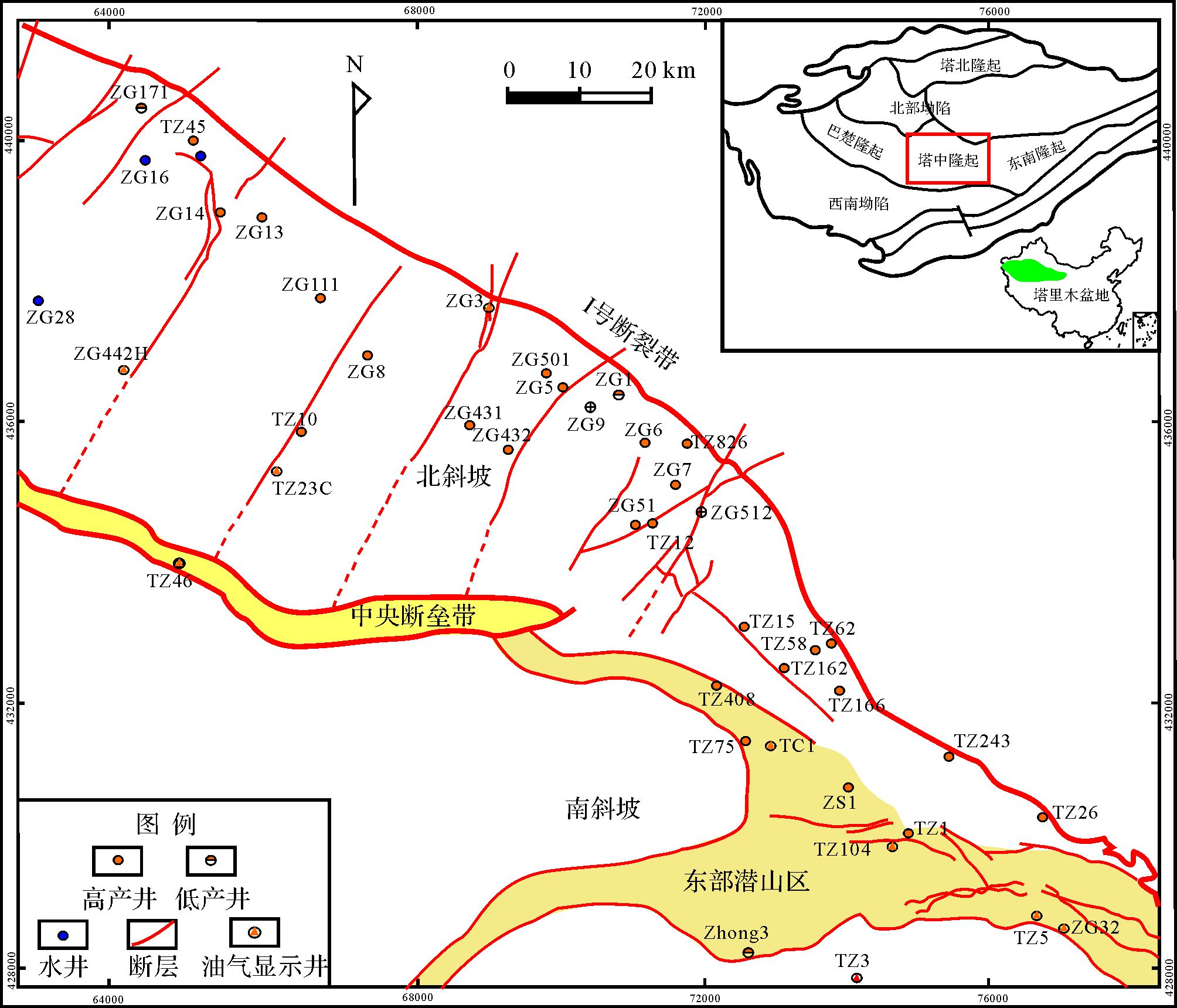
|
| 图 1 塔中地区构造图 Figure 1 The structural map of the Tazhong area in Tarim Basin |
Choquette和James[35]最早提出碳酸盐岩埋藏溶蚀成因孔隙的概念,之后得到了世界各地碳酸盐岩储层研究者的广泛支持[3, 14, 36-39],并建立了识别埋藏成因孔隙的一些标志,如分布于晚期裂缝、缝合线附近的孔洞、高温成岩矿物或含油气包裹体的矿物被溶解等。这些研究成果为深埋碳酸盐岩油气勘探提供依据。确定溶蚀作用与TSR有关,首先需要确定溶蚀发生在深埋环境。结合前人的研究成果和我们的观察和测试,总结出塔中地区如下深埋溶蚀的标志:
(1)高温沉淀的矿物(粗晶白云石、方解石等均一温度高的矿物)被溶蚀(图 2A)。粗晶白云石通常充填孔洞,或沿孔洞壁向内生长。

|
| 图 2 深埋溶蚀识别标志 A. 粗晶白云石、方解石被溶蚀,T75井,∈3,4 841.1 m,单偏光;B.黄铁矿与粗晶白云石共生,粗晶白云石被溶蚀,TZ75井,∈3,4 830.4 m,反射光;C.方解石、萤石充填在孔洞中,发育溶孔,TZ45井,O3l,6 050.1 m,单偏光;D.灰岩围岩被热液溶蚀,洞穴中充填萤石,TZ45井,O3l,6 050.1 m;E.晚期高温重晶石被溶蚀,ZG51井,O3l,5 003.1 m,正交偏光;F.缝合线被溶蚀,缝合线中充填少量沥青,ZG203,O1-2y,6 570.6 m,单偏光;G.晚期高温方解石被溶蚀,TZ243,O1p,4 468.4 m,单偏光;H. G中方解石中包裹体照片,单偏光;I. H对应的荧光照片,烃类包裹体发蓝色荧光。 Figure 2 Photomicrographs showing indicators of deep-burial dissolution |
(2)孔洞中充填了高温粗晶白云石和高硫同位素值的黄铁矿(图 2B),溶蚀孔洞极有可能是高温、深埋条件下溶蚀的产物。因为早期形成的孔洞往往含有陆源黏土矿物、浅埋条件生物成因的富32S的黄铁矿。
(3)被高温矿物交代而剩余的孔隙空间,如萤石交代方解石所残留的孔隙(图 2C,D)。从方解石和萤石的晶胞参数计算表明,1个方解石分子的体积为61.30 Å3,1个萤石分子的体积为40.76 Å3,因此,萤石交代方解石后体积减小33.5%,从而产生大量的晶间孔隙[40]。
(4)溶蚀缝洞切穿埋藏期流体沉淀矿物,或这些矿物中发育溶蚀孔洞(图 2E)。
(5)沿成岩晚期的缝合线或晚期裂缝产生溶蚀孔隙,这些缝合线或裂缝及其溶孔中常充填原油或沥青(图 2F)。
(6)含油、气或沥青包裹体的矿物被溶解,说明溶解作用发生在油、气充注和沥青形成以后(图 2G,H,I)。
本文认为TSR可能是导致塔中地区发生埋藏溶蚀作用的重要的成岩作用。TSR期间碳酸盐岩发生溶解,尤其是白云石溶解作用更强,可以用水溶硬石膏、白云石与油气烃类反应的机制解释。基于川东北飞仙关组富H2S白云岩和川西贫H2S灰岩的对比研究,Cai et al. [3]提出水溶硬石膏、白云石能与油气烃类反应,反应式如下:
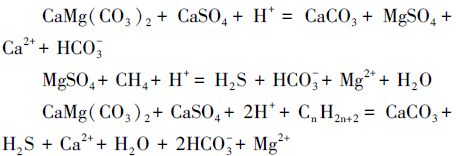
塔中地区鹰山组底部至寒武系下部肖尔布拉克组发育大量厚层白云岩,地层水中富含Mg2+,中下寒武统为膏盐岩层,地层中SO42-浓度较高。反应式中所需的弱酸性环境可能已经由少量黄铁矿沉淀产生了。在酸性环境下,HSO4-可能是地层水中的重要离子,而HSO4-和MgSO4具有相似的吉布斯自由能,因此,HSO4-和MgSO4离子对可能包含在TSR发生区域内。然而,最近的研究[41]发现MgSO4离子对的浓度比硫代硫酸盐高的多,MgSO4离子对是温度<250℃下发生TSR的合理的氧化剂。相反,HSO4-被认为是>300℃条件下的主要氧化剂。在反应中,1 mol硬石膏和1 mol白云石发生溶解,只产生1 mol方解石,导致次生孔隙形成。这一推理得到岩石学观察的支持。白云石的存在可能是研究区发生TSR的控制因素之一。
3 热化学硫酸盐还原作用的地球化学标志热化学硫酸盐还原作用(TSR)是指硫酸盐与烃类发生反应,其反应式可简化为:烃类 + SO42-→蚀变烃类+固体沥青+方解石(CO2)+ H2S [42]。若存在金属离子,H2S 可以与之结合生成金属硫化物[42]。油气储层中硫化氢和黄铁矿被认为主要是TSR形成的。
在TSR过程中,溶于水中的烃类与水溶相硫酸盐在大于120℃的条件下反应[42-46]。在储层温度条件下,硫酸盐是极为稳定的,必须通过活化作用才能反应。这种活化作用可能通过硫酸盐与H2S,元素硫,有机含硫化合物的反应或硫酸镁离子对的扰动作用实现[47-50]。TSR能够导致烃类部分或完全破坏,并产生还原形式的硫(元素硫和H2S)、氧化形式的碳(碳酸盐岩矿物和CO2)、水和有机含硫化合物[42, 45, 51-57]。
塔中地区的H2S主要是TSR成因[21, 45, 55, 58-59]。已经在塔中地区寒武系—奥陶系中发现了大量发生TSR的岩矿证据,包括TZ54井下奥陶统硬石膏的方解石化[45]及TZ12井上奥陶统方解石交代重晶石[21],TZ408和TZ75等井上寒武统白云岩地层中方解石部分交代硬石膏的现象或硬石膏的方解石假晶[59],与TSR成因方解石共生的柱状硬石膏和元素硫球状体[60]。相似的硬石膏和黄铁矿硫同位素和高温的富集12C的方解石也证实发生TSR[21, 45, 59]。并在原油中检测出2-硫代金刚烷、烷基-四氢噻吩、硫醇[55, 58, 61]等TSR相关的含硫化合物,奥陶系与石炭系原油中异常高的二苯并噻吩也被认为是与TSR有关[62]。
本次研究也观察到大量硫磺,TSR成因方解石,黄铁矿及硫酸盐共生,并发现TSR成因方解石交代硫酸盐的现象(图 3),认为奥陶系鹰山组碳酸盐岩地层内可能发生较强的TSR,例如ZG9井附近。ZG9最初测定的H2S含量甚至超过40%。然而,ZG9为水井,H2S在水中的溶解度明显高于甲烷、氮气、二氧化碳等,导致H2S含量被高估。经过模拟计算后,H2S含量估值为5%~20%[61]。ZG9附近的多口井H2S含量大于5%,如ZG6(7.8%)、ZG501(6.98%),ZG432(7.45%)[61]。一般认为H2S含量大于5%只能由TSR产生[42, 47]。Cai et al.[61]认为ZG9井储层沥青为TSR蚀变的产物。白云石和方解石均一温度(Th)指示矿物形成于高温环境(图 4)。白云岩孔洞中充填的这些方解石碳同位素接近-8‰,具有明显的有机碳来源(图 5)。同时具有高均一温度(Th)和低碳同位素值表明这些方解石由TSR形成的[3, 52, 61, 63]。方解石的盐度较高,均大于16%,说明形成于深埋藏环境。因此,可以排除土壤有机碳源造成的碳同位素低值的可能性。
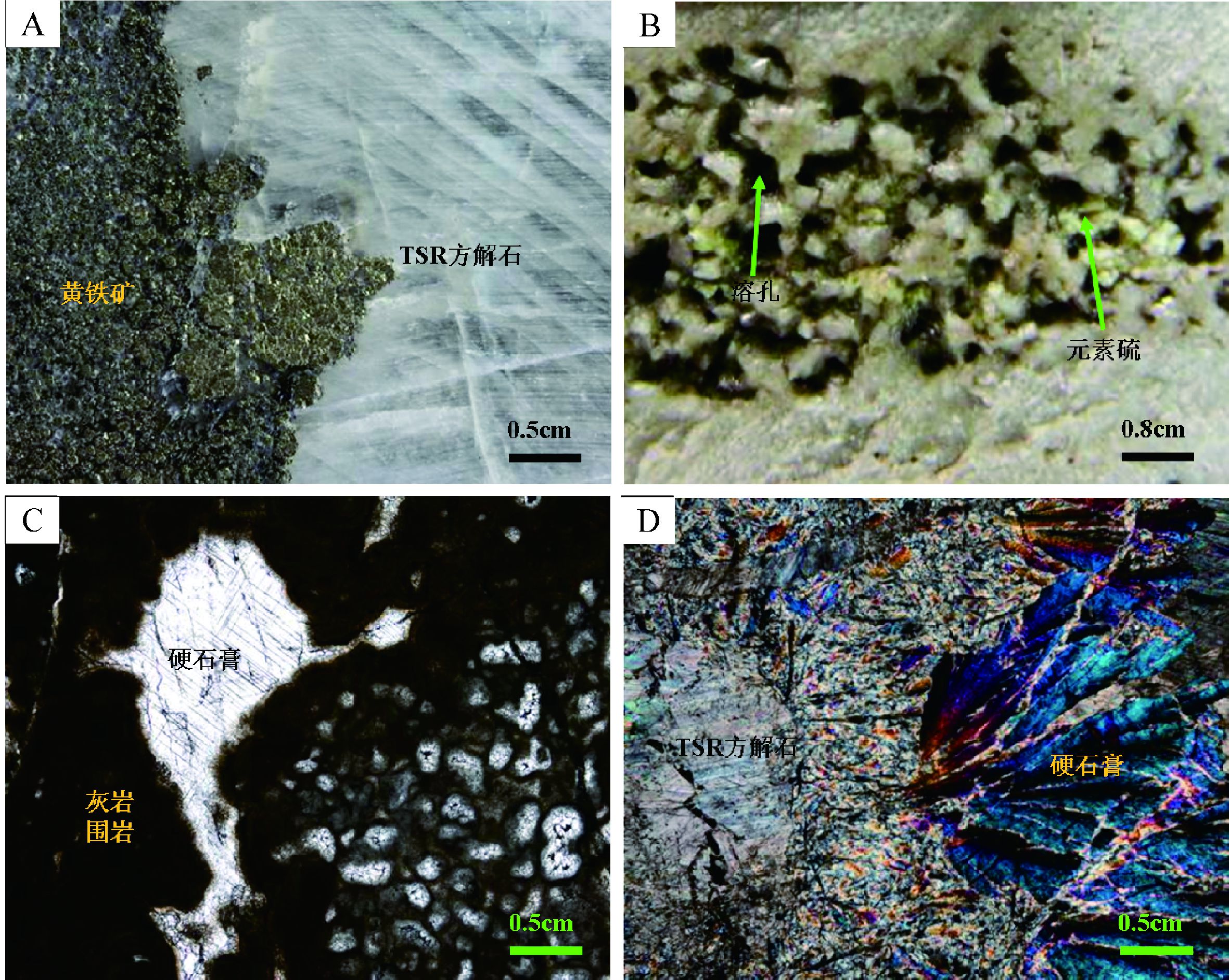
|
| 图 3 TSR反应中包含的各种成岩矿物 A.粗晶TSR方解石与黄铁矿共生,TZ3井,O1-2y,3 907.7 m,反射光;B.白云岩溶孔中充填元素硫,TZ243井,O1p,5 718.3 m;C.灰岩围岩孔洞中充填晶形很好的硬石膏,TZ162井,O1-2y,5 252.4 m,单偏光;D.TSR方解石交代硬石膏,TZ3井,O1-2y,3 907.7 m,正交偏光 Figure 3 Photos showing different types of diagenetic minerals involved in TSR reaction. |
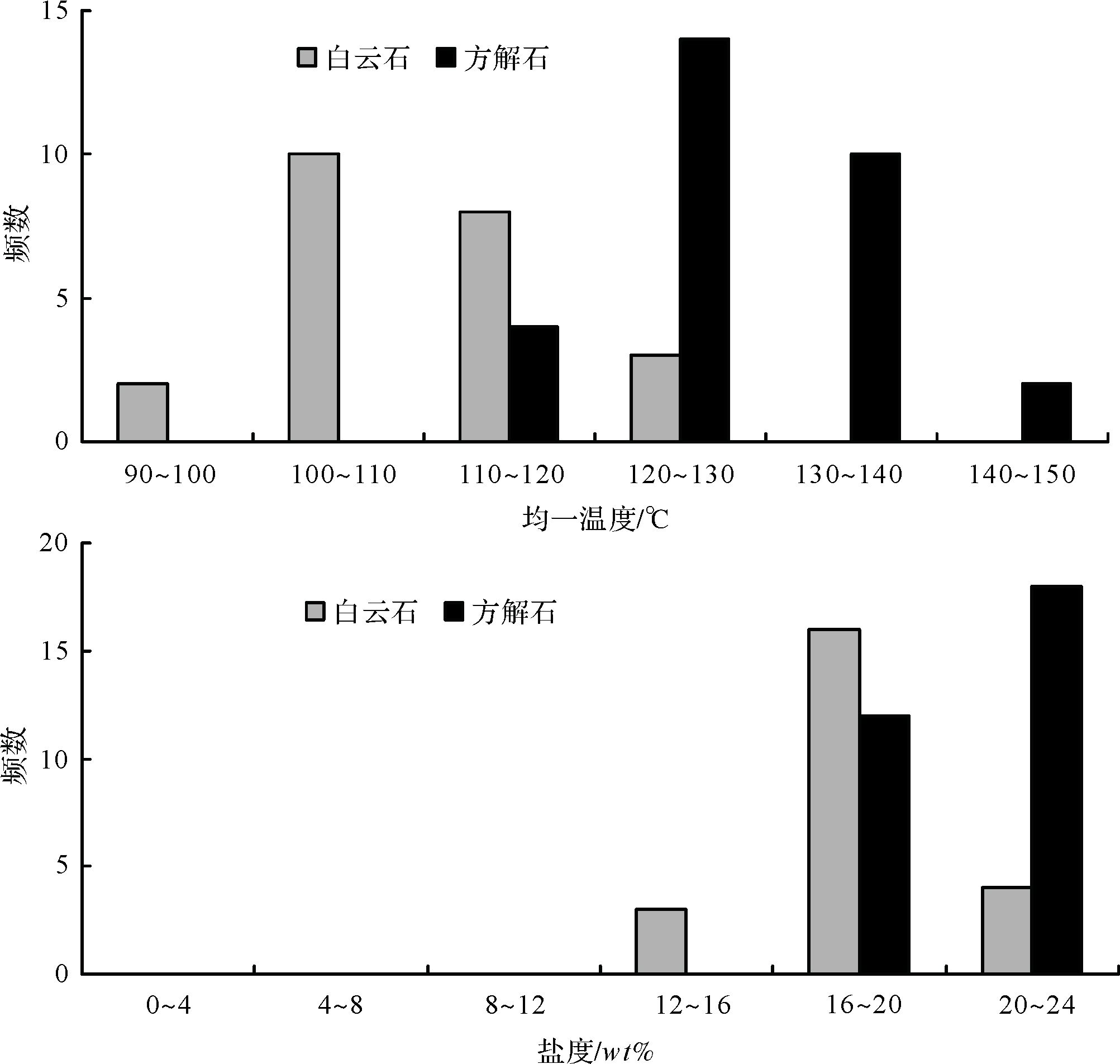
|
| 图 4 ZG9井鹰山组白云石围岩、孔洞充填方解石均一温度、盐度 Figure 4 Histograms showing homogenization temperatures and salinity measured from two-phase aqueous inclusions of calcite and dolomite from the Ordovician Yingshan Formation in Well ZG9 |
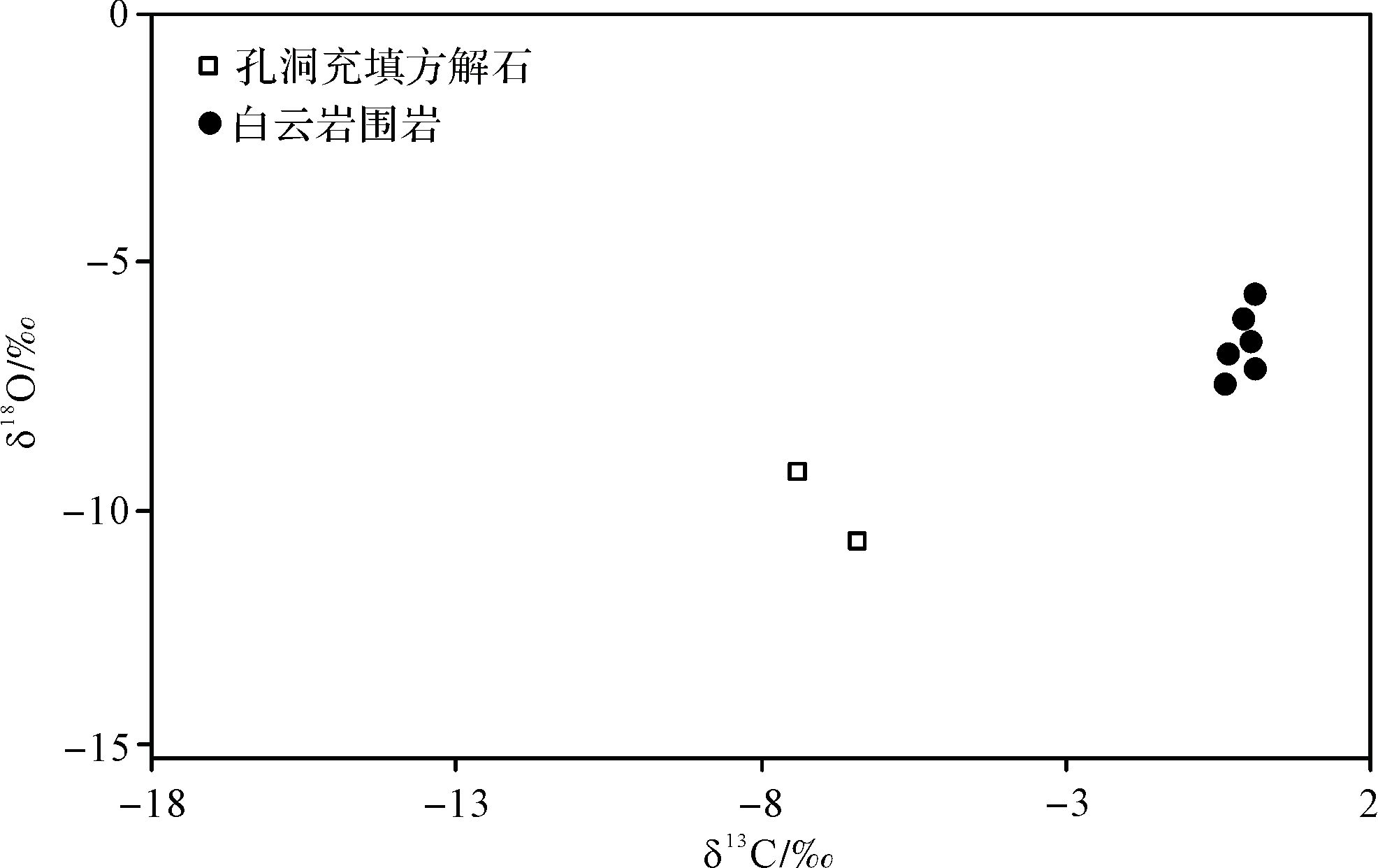
|
| 图 5 ZG9井鹰山组白云岩围岩、孔洞充填方解石碳氧同位素值对比图 Figure 5 Cross-plot of stable carbon and oxygen isotopic compositions for dolomite and calcite from the Ordovician Yingshan Formation in Well ZG9 |
塔中地区碳酸盐岩有效储层的分布主要受控于高能沉积环境(如礁滩相)、表生溶蚀,热液活动和断裂活动也起到非常重要作用[21, 28-29, 60, 64-65]。虽然与TSR相关的溶蚀作用不可能是塔中地区大规模储层形成的主要机制,但是在局部地区,TSR可能导致孔隙增加或重新分配。如ZG9井鹰山组白云岩段,其储层物性比邻井(如ZG203、ZG7井)同层位的灰岩段好得多。下文将深入剖析ZG9井白云岩溶蚀机理。
ZG9井第一筒次和第三筒次取芯段均为致密灰岩,物性很差(图 6A,C);第二筒次6 260.66 ~ 6 268.21 m段白云岩岩芯上发育白云石被溶蚀而形成的不规则孔洞,部分孔洞直径到达2~4 cm(图 6B),最大孔隙度高达27%(图 7)。镜下观察晶间溶孔发育,白云石溶解导致晶体边缘不规则呈港湾状(图 8A,B)。从扫描电镜的背散射图上能够清晰看到,固体沥青孤立分布于孔隙中央,晶形极好的白云石被溶解,说明白云石溶蚀发生在油气充注后(图 8C,D)。溶孔内经常充填晚期方解石(图 8B),却未见晚期方解石溶解。在灰岩中并未见到溶孔。ZG9井的白云岩被认为是热液白云岩化形成的[66],本次研究发现白云石均一温度为96.1℃~121.6℃(图 4),也证实白云石形成于深埋藏环境。灰岩段与白云岩段储层物性差异明显,显然不能用抗压实作用的差异来解释,倒退溶解也解释不了。我们认为这一差异是与沉积时期水动力条件、原始孔隙大小有关。无论是白云岩段、还是灰岩段,在白云岩化之前都是灰岩,但是,两者晶粒大小不同、原始孔隙度差异,导致后期深部富Mg2+的热卤水优先流入相对多孔的灰岩,发生了热液白云岩化作用。而致密的灰岩则因热流体无法进入,没有发生白云岩化作用。热液白云岩化发生,表明溶液对白云石是超饱和的,对方解石是不饱和的,于是,发生方解石的溶解作用、白云石对方解石的交代作用,而不可能同时发生白云石的溶解作用。白云岩段白云石溶解作用,可能的机理包括,①中奥陶世—晚奥陶世期间地层抬升,发生风化壳岩溶作用;②热化学硫酸盐还原作用。前人研究认为,热液白云岩化作用与二叠纪热液活动有关[66]。因此,在中奥陶世—晚奥陶世期间地层抬升之时,鹰山组尚未发生热液白云岩化作用,表明白云石溶解不可能是风化壳岩溶的产物,相反,应该发生在深埋环境中。
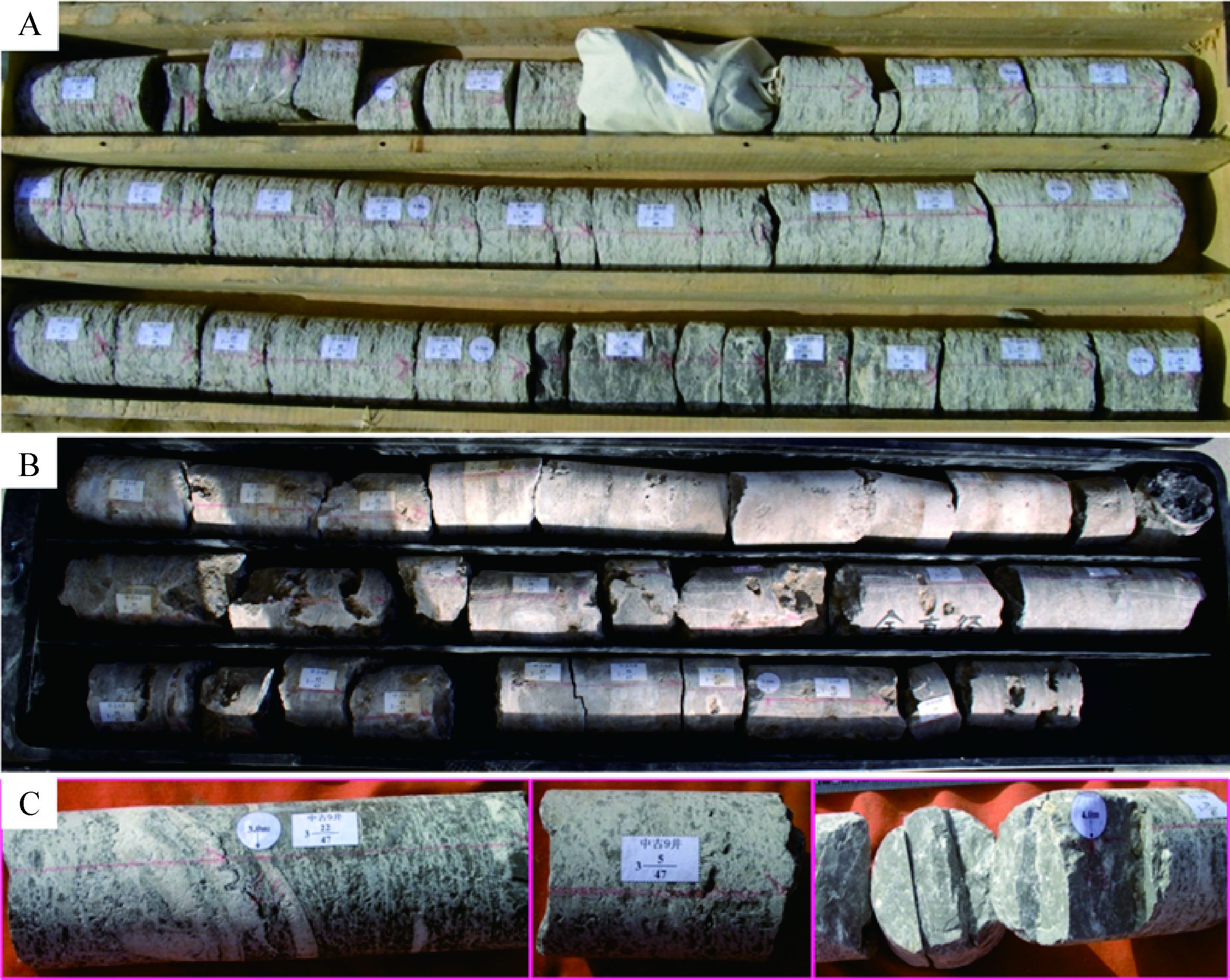
|
| 图 6 ZG9井岩芯照片 A.第一筒次,灰色泥晶灰岩,取芯井段6 241~6 249.95 m,十分致密;B.第二筒次,浅灰色白云岩,取芯井段6 260.66~6 268.21 m,孔洞极为发育;C. 灰色泥晶灰岩,取芯井段6 424~6 431 m,十分致密。 Figure 6 Photos of core samples in Well ZG9 |
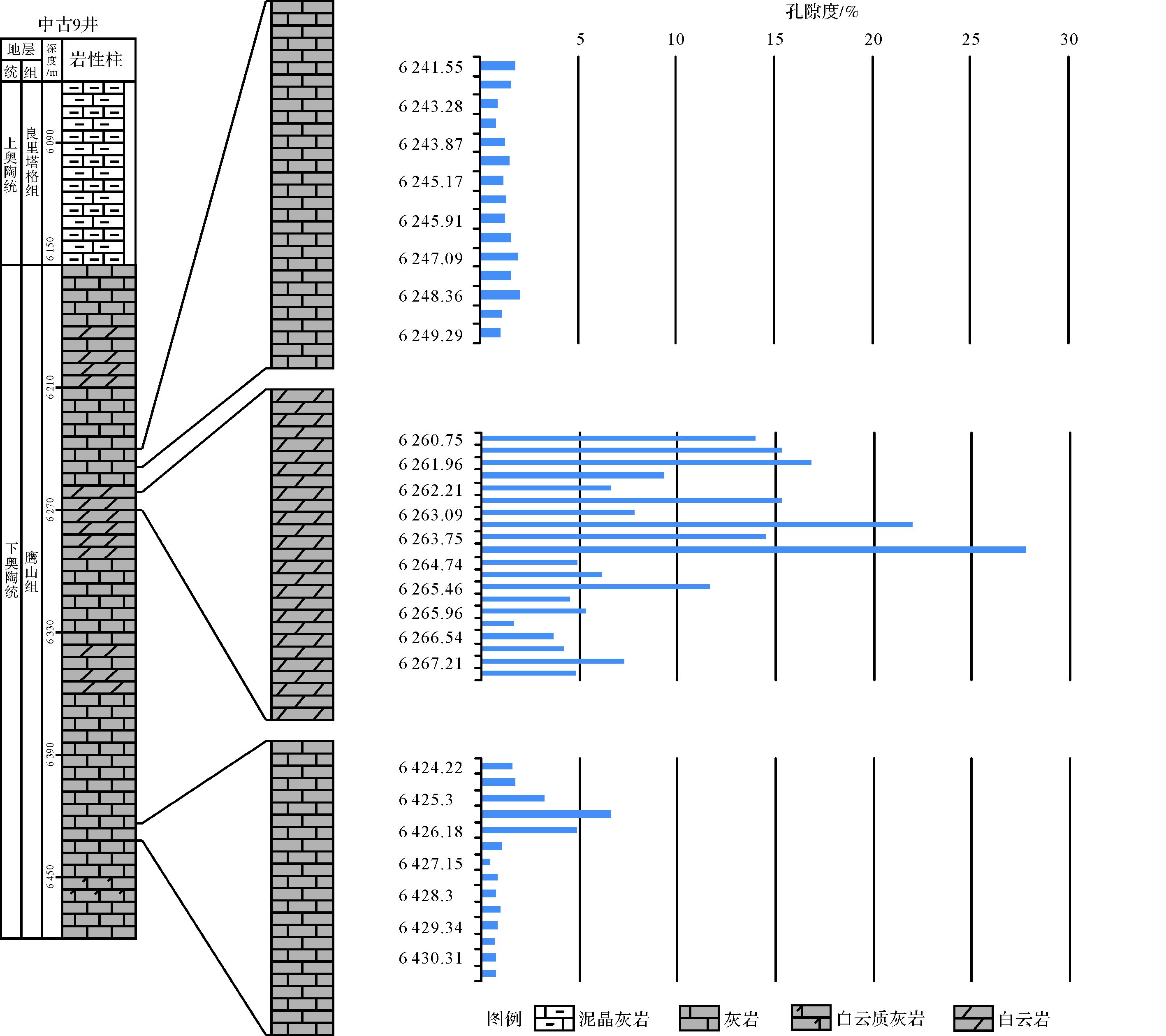
|
| 图 7 ZG9井取芯井段孔隙度变化 Figure 7 Porosity variations in the cored interval in well ZG9 |
我们在寒武系地层中也发现了TSR改造白云岩储层的现象。例如TZ75井。之前的工作已经讨论过TZ75等井上寒武统白云岩储层中发生TSR[59]。发生TSR的井段岩芯上发现大量白云岩的溶孔,薄片观察表明储层中的部分孔隙由晚期白云石和晚期方解石溶蚀形成的(图 2A)。晚期高温方解石和白云石溶蚀孔隙的存在提供了埋藏溶蚀作用的溶蚀效应的证据。岩石学观察表明,TZ75井多孔白云岩储层常与丰富的黄铁矿、硬石膏和TSR方解石共生[59]。深埋溶蚀孔隙与TSR反应物和生成物的密切共生关系,表明溶蚀作用很可能与TSR有关。如图 9所示,塔中75井岩芯孔隙度结果显示,发生TSR的上寒武统下部的孔隙度明显高于之上的各个地层,而未发生TSR的上寒武统上部、蓬莱坝组与良里塔格组孔隙度相近。类似地,ZS1C井6 912~6 932 m白云岩储层为气层,硫化氢含量高达11.4%,孔隙度为6.5%,储层段上下的地层孔隙度都在1%以下。这些现象说明TSR作用可能一定程度上增加了白云岩的孔隙度。
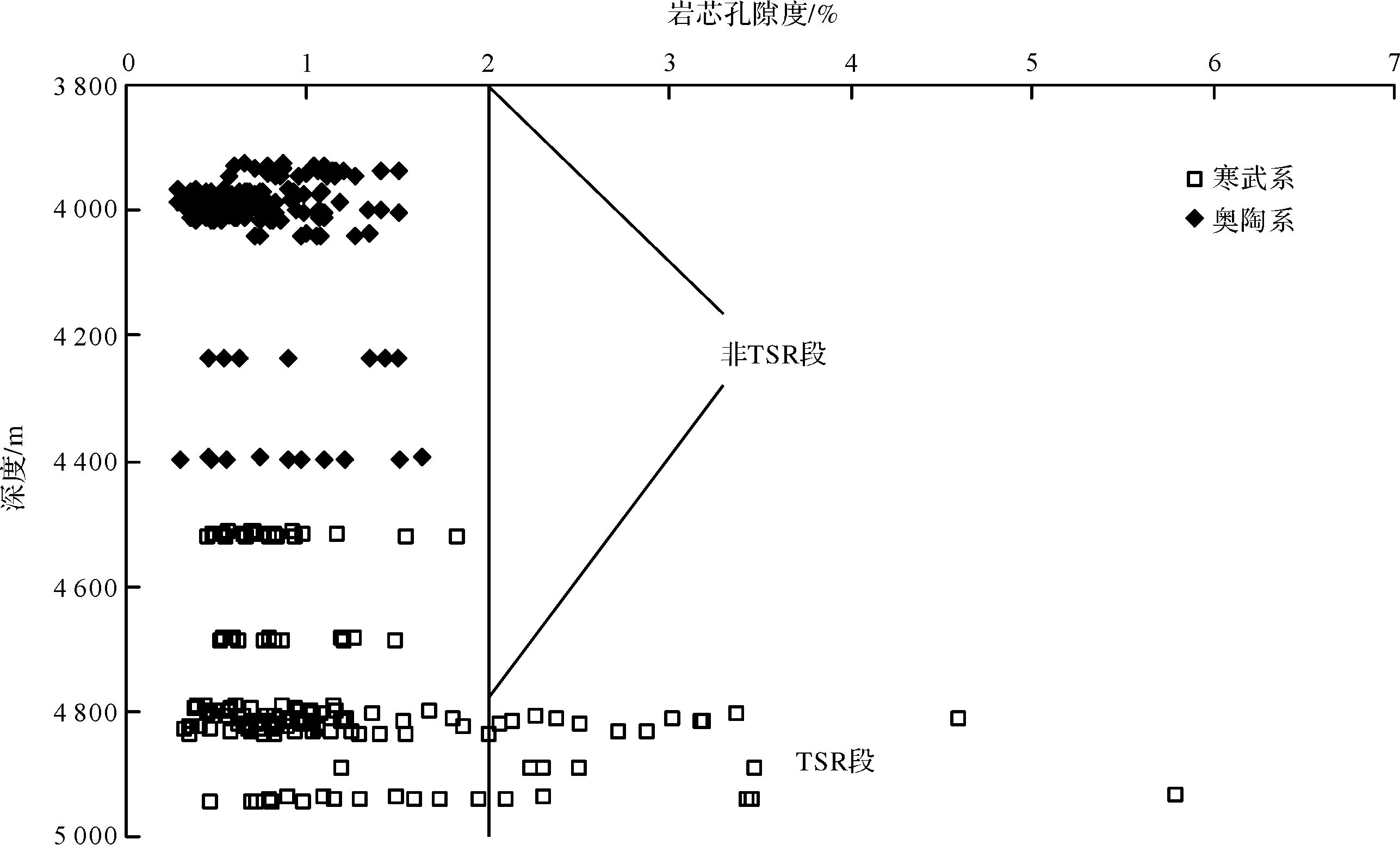
|
| 图 9 TZ75井岩芯孔隙度与深度关系图 Figure 9 Core porosity changes in TSR and non-TSR interval in well TZ75 |
(1)塔中地区寒武系—奥陶系发生埋藏溶蚀作用,识别标志包括:高温或含烃类包裹体的晚期成岩矿物被溶蚀或切穿,沿成岩晚期的缝合线或晚期裂缝产生溶蚀孔隙。
(2)TSR溶蚀的机制主要为水溶硬石膏、白云石与油气烃类反应。这种机制在塔中深部的寒武系储层中可能广泛存在,有利于深埋优质白云岩储层的形成。
(3)塔中地区寒武系—奥陶系发现大量硬石膏、重晶石、黄铁矿、方解石、沥青和硫化氢,岩矿、均一温度及同位素证据说明发生TSR。
(4)TSR可以促进深埋碳酸盐岩的溶解,导致孔隙增加或重新分配。在深埋条件下,TSR对白云岩的改造作用强于灰岩,因此更易成为优质储层。
致谢: 在论文撰写过程中受到了陈代钊等专家的亲切指导,在此一并感谢。| [1] | 赵文智, 胡素云, 刘伟, 等. 再论中国陆上深层海相碳酸盐岩油气地质特征与勘探前景[J]. 天然气工业, 2014 , 34 (4) : 1 –9. [ Zhao Wenzhi, Hu Suyun, Liu Wei, et al. Petroleum geological features and exploration prospect in deep marine carbonate strata onshore China:a further discussion[J]. Natural Gas Industry, 2014 , 34 (4) : 1 –9. ] |
| [2] | 王招明, 谢会文, 陈永权, 等. 塔里木盆地中深1井寒武系盐下白云岩原生油气藏的发现与勘探意义[J]. 中国石油勘探, 2014 , 19 (2) : 1 –13. [ Wang Zhaoming, Xie Huiwen, Chen Yongquan, et al. Discovery and exploration significance of Cambrian subsalt dolomite original hydrocarbon reservoir at Well Zhongshen-1 in Tarim Basin[J]. China Petroleum Exploration, 2014 , 19 (2) : 1 –13. ] |
| [3] | Cai Chunfang, He Wenxian, Jiang Lei, et al. Petrological and geochemical constraints on porosity difference between Lower Triassic sour-and sweet-gas carbonate reservoirs in the Sichuan Basin[J]. Marine and Petroleum Geology, 2014 , 56 : 34 –50. DOI: 10.1016/j.marpetgeo.2014.04.003 |
| [4] | Zhu Dongya, Meng Qingqiang, Jin Zhijun, et al. Formation mechanism of deep Cambrian dolomite reservoirs in the Tarim basin, northwestern China[J]. Marine and Petroleum Geology, 2015 , 59 : 232 –244. DOI: 10.1016/j.marpetgeo.2014.08.022 |
| [5] | Heydari E. The role of burial diagenesis in hydrocarbon destruction and H2S accumulation, upper Jurassic Smackover Formation, Black Creek Field, Mississippi[J]. AAPG Bulletin, 1997 , 81 (1) : 26 –45. |
| [6] | Vandeginste V, Swennen R, Reed M H, et al. Host rock dolomitization and secondary porosity development in the Upper Devonian Cairn Formation of the Fairholme carbonate complex (South-west Alberta, Canadian Rockies):diagenesis and geochemical modelling[J]. Sedimentology, 2009 , 56 (7) : 2044 –2060. DOI: 10.1111/sed.2009.56.issue-7 |
| [7] | Schmidt V, McIlreath I A, Budwill A E. Origin and diagenesis of Middle Devonian pinnacle reefs encased in evaporites, "A" and "E" pools, Rainbow Field, Alberta[M]//Roehl P O, Choquette P W. Carbonate Petroleum Reservoirs. New York:Springer-Verlag, 1985:140-160. |
| [8] | James N P, Choquette P W. Diagenesis of Limestones-the meteoric diagenetic environment[M]//Moore C. Carbonate Diagenesis and Porosity. Amsterdam:Elsevier, 1984:161-194. |
| [9] | Schlager W. Carbonate Sedimentology and Sequence Stratigraphy[M]. SEPM Concepts in Sedimentology and Paleontology, 2005: 200. |
| [10] | Weidlich O. Meteoric diagenesis in carbonates below karst unconformities:heterogeneity and control factors[M]//van Buchem F S P, Gerdes K D, Esteban M. Mesozoic and Cenozoic Carbonate Systems of the Mediterranean and the Middle East:Stratigraphic and Diagenetic Reference Models. Geological Society, London, Special Publication, 2010, 329(1):291-315. |
| [11] | Halley R B, Schmoker J W. High-porosity Cenozoic carbonate rocks of south Florida:progressive loss of porosity with depth[J]. AAPG Bulletin, 1983 , 67 (2) : 191 –200. |
| [12] | Scholle P A, Halley R B. Burial diagenesis:out of sight, out of mind[C]//Schneidermann N, Harris P M. Carbonate Cements. Tulsa, OK:SEPM Special Publication, 1985, 36:309-334. |
| [13] | Machel H G, Lonnee J. Hydrothermal dolomite-a product of poor definition and imagination[J]. Sedimentary Geology, 2002 , 152 (3/4) : 163 –171. |
| [14] | Mazzullo S L, Harris P M. Mesogenetic dissolution:its role in porosity development in carbonate reservoirs[J]. AAPG Bulletin, 1992 , 76 (5) : 607 –620. |
| [15] | Davies G R, Smith L B, J r. Structurally controlled hydrothermal dolomite reservoir facies:an overview[J]. AAPG Bulletin, 2006 , 90 (11) : 1641 –1690. DOI: 10.1306/05220605164 |
| [16] | Al-Aasm I. Origin and characterization of hydrothermal dolomite in the Western Canada Sedimentary Basin[J]. Journal of Geochemical Exploration, 2000 : 78-79 –9-15. |
| [17] | Cantrell D L, Swart P K, Hagerty R M. Genesis and characterization of dolomite, Arab-D reservoir, Ghawar field, Saudi Arabia[J]. GeoArabia, 2004 , 9 (2) : 1 –26. |
| [18] | Gasparrini M, Bechstädt T, Boni M. Massive hydrothermal dolomites in the southwestern Cantabrian Zone (Spain) and their relation to the Late Variscan evolution[J]. Marine and Petroleum Geology, 2006 , 23 (5) : 543 –568. DOI: 10.1016/j.marpetgeo.2006.05.003 |
| [19] | Smith L B, J r. Origin and reservoir characteristics of Upper Ordovician Trenton-Black River hydrothermal dolomite reservoirs in New York[J]. AAPG Bulletin, 2006 , 90 (11) : 1691 –1718. DOI: 10.1306/04260605078 |
| [20] | Jin Zhijun, Zhu Dongya, Zhang Xuefeng, et al. Hydrothermally fluoritized Ordovician carbonates as reservoir rocks in the Tazhong area, Centraltarim Basin, NW China[J]. Journal of Petroleum Geology, 2006 , 29 (1) : 27 –40. DOI: 10.1111/j.1747-5457.2006.00027.x |
| [21] | Cai Chunfang, Li Kaikai, Li Hongtao, et al. Evidence for cross formational hot brine flow from integrated 87Sr/86Sr, REE and fluid inclusions of the Ordovician veins in Central Tarim, China[J]. Applied Geochemistry, 2008 , 23 (8) : 2226 –2235. DOI: 10.1016/j.apgeochem.2008.03.009 |
| [22] | 潘文庆, 胡秀芳, 刘亚雷, 等. 塔里木盆地西北缘奥陶系碳酸盐岩中两种来源热流体的地质与地球化学证据[J]. 岩石学报, 2012 , 28 (8) : 2515 –2524. [ Pan Wenqing, Hu Xiufang, Liu Yalei, et al. Geological and geochemical evidence for two sources of hydrothermal fluids found in Ordovician carbonate rocks in northwestern Tarim Basin[J]. Acta Petrologica Sinica, 2012 , 28 (8) : 2515 –2524. ] |
| [23] | 金之钧, 朱东亚, 胡文瑄, 等. 塔里木盆地热液活动地质地球化学特征及其对储层影响[J]. 地质学报, 2006 , 80 (2) : 245 –254. [ Jin Zhijun, Zhu Dongya, Hu Wenxuan, et al. Geological and geochemical signatures of hydrothermal activity and their influence on carbonate reservoir beds in the Tarim Basin[J]. Acta Geologica Sinica, 2006 , 80 (2) : 245 –254. ] |
| [24] | 吴茂炳, 王毅, 郑孟林, 等. 塔中地区奥陶纪碳酸盐岩热液岩溶及其对储层的影响[J]. 中国科学D辑:地球科学, 2007 , 37 (Suppl.) : 83 –92. [ Wu Maobing, Wang Yi, Zheng Menglin, et al. The hydrothermal karstification and its effect on Ordovician carbonate reservoir in Tazhong uplift of Tarim Basin, Northwest China[J]. Science in China Series D:Earth Sciences, 2007 , 37 (Suppl.) : 83 –92. ] |
| [25] | 吕修祥, 解启来, 杨宁, 等. 塔里木盆地深部流体改造型碳酸盐岩油气聚集[J]. 科学通报, 2007 , 52 (Suppl.) : 142 –148. [ Lü Xiuxiang, Xie Qilai, Yang Ning, et al. Hydrocarbon accumulation in deep fluid modified carbonate rock in the Tarim Basin[J]. Chinese Science Bulletin, 2007 , 52 (Suppl.) : 142 –148. ] |
| [26] | 朱东亚, 金之钧, 胡文瑄, 等. 塔里木盆地深部流体对碳酸盐岩储层影响[J]. 地质论评, 2012 , 54 (3) : 348 –354. [ Zhu Dongya, Jin Zhijun, Hu Wenxuan, et al. Effects of deep fluid on carbonates reservoir in Tarim Basin[J]. Geological Review, 2012 , 54 (3) : 348 –354. DOI: 10.1080/00206814.2010.543789 ] |
| [27] | 潘文庆, 刘永福, DicksonJ A D, 等. 塔里木盆地下古生界碳酸盐岩热液岩溶的特征及地质模型[J]. 沉积学报, 2009 , 27 (5) : 983 –994. [ Pan Wenqing, Liu Yongfu, Dickson J A D, et al. The geological model of hydrothermal activity in outcrop and the characteristics of carbonate hydrothermal karst of Lower Paleozoic in Tarim Basin[J]. Acta Sedimentologica Sinica, 2009 , 27 (5) : 983 –994. ] |
| [28] | 杨海军, 李开开, 潘文庆, 等. 塔中地区奥陶系埋藏热液溶蚀流体活动及其对深部储层的改造作用[J]. 岩石学报, 2012 , 28 (3) : 783 –792. [ Yang Haijun, Li Kaikai, Pan Wenqing, et al. Burial hydrothermal dissolution fluid activity and its transforming effect on the reservoirs in Ordovician in Central Tarim[J]. Acta Petrologica Sinica, 2012 , 28 (3) : 783 –792. ] |
| [29] | Li Kaikai, Cai Chunfang, Jia Lianqi, et al. The role of thermochemical sulfate reduction in the genesis of high-quality deep marine reservoirs within the central Tarim Basin, western China[J]. Arabian Journal of Geosciences, 2014 , 8 (7) : 4443 –4456. |
| [30] | Krouse H R, Viau C A, Eliuk L S, et al. Chemical and isotopic evidence of thermochemical sulphate reduction by light hydrocarbon gases in deep carbonate reservoirs[J]. Nature, 1988 , 333 (6172) : 415 –419. DOI: 10.1038/333415a0 |
| [31] | Baric G, Mesic I, Jungwirth M. Petroleum geochemistry of the deep part of the Drava Depression, Croatia[J]. Organic Geochemistry, 1998 , 29 (1/2/3) : 571 –582. |
| [32] | 朱光有, 张水昌, 梁英波, 等. TSR对深部碳酸盐岩储层的溶蚀改造-四川盆地深部碳酸盐岩优质储层形成的重要方式[J]. 岩石学报, 2006 , 22 (8) : 2182 –2194. [ Zhu Guangyou, Zhang Shuichang, Liang Yingbo, et al. Dissolution and alteration of the deep carbonate reservoirs by TSR:an important type of deep-buried high-quality carbonate reservoirs in Sichuan basin[J]. Acta Petrologica Sinica, 2006 , 22 (8) : 2182 –2194. ] |
| [33] | Ma Yongsheng, Guo Xusheng, Guo Tonglou, et al. The Puguang gas field:new giant discovery in the mature Sichuan Basin, southwest China[J]. AAPG Bulletin, 2007 , 91 (5) : 627 –643. DOI: 10.1306/11030606062 |
| [34] | 贾承造. 中国塔里木盆地构造特征与油气[M]. 北京: 石油工业出版社, 1997: 1-438. [ Jia Chengzao. Structural Characteristics and Oil and Gas in China's Tarim Basin[M]. Beijing: Petroleum Industrial Press, 1997: 1-438. ] |
| [35] | Choquette P W, James N P. Diagenesis #12. Diagenesis in limestones-3. The deep burial environmen[J]. Geoscience Canada, 1987 , 14 (1) : 3 –35. |
| [36] | Amthor J E, Mountjoy E W, Machel H G. Subsurface dolomites in upper Devonian Leduc Formation buildups, central part of Rimbey-Meadowbrook reef trend, Alberta, Canada[J]. Bulletin of Canadian Petroleum Geology, 1993 , 41 (2) : 164 –185. |
| [37] | Mountjoy E W, Machel H G, Green D, et al. Devonian matrix dolomites and deep burial carbonate cements:a comparison between the Rimbey-Meadowbrook reef trend and the deep basin of west-central Alberta[J]. Bulletin of Canadian Petroleum Geology, 1999 , 47 (4) : 487 –509. |
| [38] | Wendte J. Origin of molds in dolostones formed by the dissolution of calcitic grains:evidence from the Swan Hills Formation in west-central Alberta and other Devonian formations in Alberta and northeastern British Columbia[J]. Bulletin of Canadian Petroleum Geology, 2006 , 54 (2) : 91 –109. DOI: 10.2113/gscpgbull.54.2.91 |
| [39] | BiehlB C, Reuning L, Schoenherr J, et al. Impacts of hydrothermal dolomitization and thermochemical sulfate reduction on secondary porosity creation in deeply buried carbonates:a case study from the Lower Saxony Basin, northwest Germany[J]. AAPG Bulletin, 2016 , 100 (4) : 597 –621. DOI: 10.1306/01141615055 |
| [40] | 朱东亚, 胡文瑄, 宋玉才, 等. 塔里木盆地塔中45井油藏萤石化特征及其对储层的影响[J]. 岩石矿物学杂志, 2005 , 24 (3) : 205 –215. [ Zhu Dongya, Hu Wenxuan, Song Yucai, et al. Fluoritization in Tazhong 45 reservoir:characteristics and its effect on the reservoir bed[J]. Acta Petrologica et Mineralogica, 2005 , 24 (3) : 205 –215. ] |
| [41] | He Kun, Zhang Shuichang, Mi Jingkui, et al. The speciation of aqueous sulfate and its implication on the initiation mechanisms of TSR at different temperatures[J]. Applied Geochemistry, 2014 , 43 (4) : 121 –131. |
| [42] | Machel H G. Bacterial and thermochemical sulfate reduction in diagenetic settings-old and new insights[J]. Sedimentary Geology, 2001 , 140 (1/2) : 143 –175. |
| [43] | Toland W L. Oxidation of organic compounds with aqueous sulfate[J]. Journal of the American Chemical Society, 1960 , 82 (8) : 1911 –1916. DOI: 10.1021/ja01493a020 |
| [44] | Worden R H, Smalley P C, Oxtoby N H. Gas souring by thermochemical sulfate reduction at 140℃[J]. AAPG Bulletin, 1995 , 79 : 854 –863. |
| [45] | Cai Chunfang, Hu Wangshui, Worden R H. Thermochemical sulphate reduction in Cambro-Ordovician carbonates in Central Tarim[J]. Marine and Petroleum Geology, 2001 , 18 (6) : 729 –741. DOI: 10.1016/S0264-8172(01)00028-9 |
| [46] | Cross M M, Manning D A C, Bottrell S H, et al. Thermochemical sulphate reduction (TSR):experimental determination of reaction kinetics and implications of the observed reaction rates for petroleum reservoirs[J]. Organic Geochemistry, 2004 , 35 (4) : 393 –404. DOI: 10.1016/j.orggeochem.2004.01.005 |
| [47] | Orr W L. Geologic and geochemical controls on the distribution of hydrogen sulfide in natural gas[M]//Campos R, Goni J. Advances in Organic Geochemistry 1975. Enadisma, Madrid, Spain, 1977:571-597. |
| [48] | Worden R H, Smalley P C, Oxtoby N H. The effects of thermochemical sulfate reduction upon formation water salinity and oxygen isotopes in carbonate gas reservoirs[J]. Geochimica et Cosmochimica Acta, 1996 , 60 (20) : 3925 –3931. DOI: 10.1016/0016-7037(96)00216-5 |
| [49] | Ma Anlai, Zhang Shuichang, Zhang Dajiang. Ruthenium-ion-catalyzed oxidation of asphaltenes of heavy oils in Lunnan and Tahe oilfields in Tarim Basin, NW China[J]. Organic Geochemistry, 2008 , 39 (11) : 1502 –1511. DOI: 10.1016/j.orggeochem.2008.07.016 |
| [50] | Zhang Tongwei, Ellis G S, Walters C C, et al. Geochemical signatures of thermochemical sulfate reduction in controlled hydrous pyrolysis experiments[J]. Organic Geochemistry, 2008 , 39 (3) : 308 –328. DOI: 10.1016/j.orggeochem.2007.12.007 |
| [51] | Machel H G, Krouse H R, Sassen R. Products and distinguishing criteria of bacterial and thermochemical sulfate reduction[J]. Applied Geochemistry, 1995 , 10 (4) : 373 –389. DOI: 10.1016/0883-2927(95)00008-8 |
| [52] | Worden R H, Smalley P C. H2S-producing reactions in deep carbonate gas reservoirs:khuff formation, Abu Dhabi[J]. Chemical Geology, 1996 , 133 (1/2/3/4) : 157 –171. |
| [53] | Cai Chunfang, Worden R H, Bottrell S H, et al. Thermochemical sulphate reduction and the generation of hydrogen sulphide and thiols (mercaptans) in Triassic carbonate reservoirs from the Sichuan basin, China[J]. Chemical Geology, 2003 , 202 (1/2) : 39 –57. |
| [54] | Cai Chunfang, Xie Zengye, Worden R H, et al. Methane-dominated thermochemical sulphate reduction in the Triassic Feixianguan Formation East Sichuan Basin, China:towards prediction of fatal H2S concentrations[J]. Marine and Petroleum Geology, 2004 , 21 (10) : 1265 –1279. DOI: 10.1016/j.marpetgeo.2004.09.003 |
| [55] | Cai Chungfang, Zhang Chunming, Cai Liulu, et al. Origins of Palaeozoic oils in the Tarim Basin:evidence from sulfur isotopes and biomarkers[J]. Chemical Geology, 2009 , 268 (3/4) : 197 –210. |
| [56] | Cai Chunfang, Li Kaikai, Zhu Yangming, et al. TSR origin of sulfur in the Permian and Triassic reservoir bitumen in East Sichuan Basin, China[J]. Organic Geochemistry, 2010 , 41 (9) : 871 –878. DOI: 10.1016/j.orggeochem.2010.03.009 |
| [57] | Cai Chunfang, Zhang Chunming, He Hong, et al. Carbon isotope fractionation during methane-dominated TSR in East Sichuan Basin gasfields, China:a review[J]. Marine and Petroleum Geology, 2013 , 48 : 100 –110. DOI: 10.1016/j.marpetgeo.2013.08.006 |
| [58] | 姜乃煌, 朱光有, 张水昌, 等. 塔里木盆地塔中83井原油中检测出2-硫代金刚烷及其地质意义[J]. 科学通报, 2007 , 52 (24) : 2871 –2875. [ Jiang Naihuang, Zhu Guangyou, Zhang Shuichang, et al. Detection of 2-thiaadamantanes in the oil from Well TZ-83 in Tarim Basin and its geological implication[J]. Chinese Science Bulletin, 2007 , 52 (24) : 2871 –2875. ] |
| [59] | Jia L, Cai C, Yang H, et al. Thermochemical and bacterial sulfate reduction in the Cambrian and Lower Ordovician carbonates in the Tazhong Area, Tarim Basin, NW China:evidence from fluid inclusions, C, S, and Sr isotopic data[J]. Geofluids, 2015 , 15 (24) : 421 –437. |
| [60] | 孙玉善, 韩杰, 张丽娟, 等. 塔里木盆地塔中地区上奥陶统礁滩体基质次生孔隙成因——以塔中62井区为例[J]. 石油勘探与开发, 2007 , 34 (5) : 541 –547. [ Sun Yushan, Han Jie, Zhang Lijuan, et al. Genesis of reef flat body matrix secondary pores in Upper Ordovician in central area of Tarim Basin[J]. Petroleum Exploration and Development, 2007 , 34 (5) : 541 –547. ] |
| [61] | Cai Chunfang, Hu Guoyi, Li Hongxia, et al. Origins and fates of H2S in the Cambrian and Ordovician in Tazhong area:evidence from sulfur isotopes, fluid inclusions and production data[J]. Marine and Petroleum Geology, 2015 , 67 : 408 –418. DOI: 10.1016/j.marpetgeo.2015.05.007 |
| [62] | Li Sumei, Shi Quan, Pang Xiongqi, et al. Origin of the unusually high dibenzothiophene oils in Tazhong-4 Oilfield of Tarim Basin and its implication in deep petroleum exploration[J]. Organic Geochemistry, 2012 , 48 : 56 –80. DOI: 10.1016/j.orggeochem.2012.04.008 |
| [63] | Jia Lianqi, Cai Chunfang, Jiang Lei, et al. Petrological geochemical constraints on diagenesis and deep burial dissolution of the Ordovician carbonate reservoirs in the Tazhong area, Tarim Basin, NW China[J]. Marine and Petroleum Geology, 2016 , 78 : 271 –290. DOI: 10.1016/j.marpetgeo.2016.09.031 |
| [64] | Hao Fang, Guo Tonglou, Zhu Yangming, et al. Evidence for multiple stages of oil cracking and thermochemical sulfate reduction in the Puguang gas field, Sichuan Basin, China[J]. AAPG Bulletin, 2008 , 92 (5) : 611 –637. DOI: 10.1306/01210807090 |
| [65] | 邬光辉, 李启明, 肖中尧, 等. 塔里木盆地古隆起演化特征及油气勘探[J]. 大地构造与成矿学, 2009 , 33 (1) : 124 –130. [ Wu Guanghui, Li Qiming, Xiao Zhongrao, et al. The evolution characteristics of Palaeo-uplifts in Tarim Basin and its exploration directions for oil and gas[J]. Geotectonica et Metallogenia, 2009 , 33 (1) : 124 –130. ] |
| [66] | Lin Changsong, Yang Haijum, Liu Jingyan, et al. Distribution and erosion of the Paleozoic tectonic unconformities in the Tarim Basin, Northwest China:significance for the evolution of Paleo-uplifts and tectonic geography during deformation[J]. Journal of Asian Earth Sciences, 2012 , 46 : 1 –19. DOI: 10.1016/j.jseaes.2011.10.004 |
| [67] | 赵文智, 沈安江, 胡素云, 等. 塔里木盆地寒武-奥陶系白云岩储层类型与分布特征[J]. 岩石学报, 2012 , 28 (3) : 758 –768. [ Zhao Wenzhi, Shen Anjiang, Hu Suyun, et al. Types and distributional features of Cambrian-Ordovician dolostone reservoirs in Tarim Basin, northwestern China[J]. Acta Petrologica Sinica, 2012 , 28 (3) : 758 –768. ] |
 2016, Vol. 34
2016, Vol. 34



